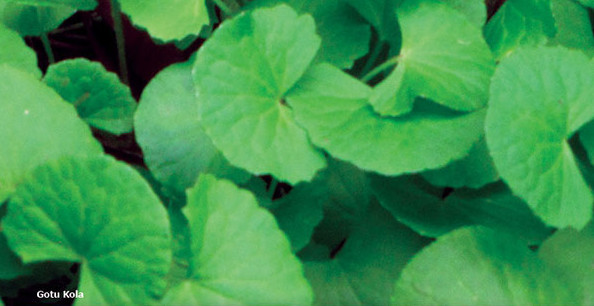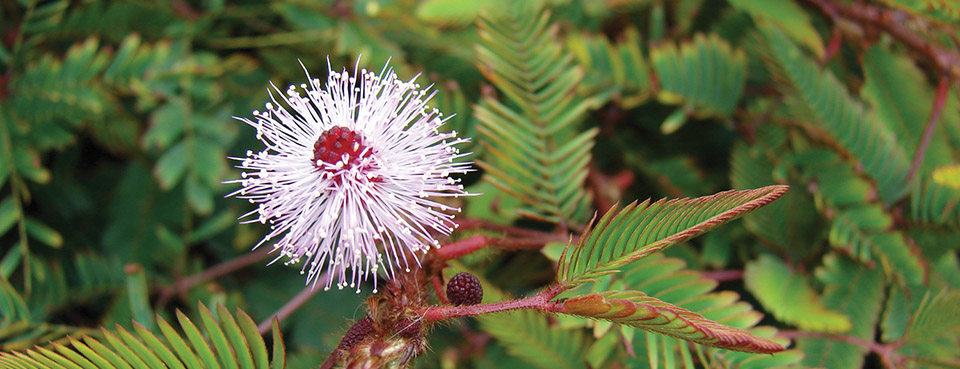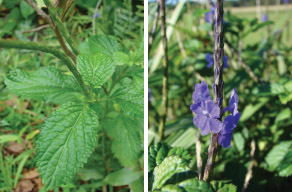
Natural Plant Medicine is Everywhere You Look
 By Barbara Fahs
By Barbara Fahs
You already know about them. Those dandelions you struggle to keep out of your lawn? Medicinal. The persistent weeds in your vegetable garden? Many of them have uses as medicine. Even some “weeds” that grow on bare pāhoehoe (smooth lava), such as pohe kula, and ‘uha loa, were used as medicine by Hawaiian people of a former era.
Identifying Wild Medicinals
Before you pull or poison any plant, check with a local nursery, or search the library or internet to learn about the plants on your property. Even though you might not use all of the plants you find, knowing about them can help their population to thrive and survive, especially if they are native Hawaiian plants.
A good book for identifying the plants that grow in Hawai‘i is Polynesian Herbal Medicine, by Dr. W. Arthur Whistler. It contains nearly 100 pages of photographs and detailed descriptions of plants that have known medicinal properties, including ways in which earlier residents used them.
Common Examples of Wild Medicinals
‘Uha Loa: The pale green ‘uha loa (Waltheria americana and W. indica) is possibly an early Polynesian introduction that belongs to the Amaranth plant family. It thrives in hot, dry areas. Kumu Dane Silva of the Ohana Learning Institute writes, “‘Uha loa may be used both internally and externally. Consuming it as a tea or oral rinse has both traditional and scientific support for self-care and prevention of inflammatory disorders.”
“External use as a topical or transdermal application improves circulation in the inflamed extremities.”
In earlier times, other uses included drinking the juice from its root bark for sore throats. The roots, leaves and flowers were mixed with other plants for asthma: to prepare this medicine, practitioners pressed out the juice, then strained and heated it. Patients were instructed to drink it daily for five days. A tea was also made from the leaves and was said to assist those suffering from arthritis.
Pohe Kula: Commonly called gotu kola (Centella asiatica), this dainty little vine grows in lawns and on bare rock. It came to Western Polynesia through early European explorers and spread its way east to Hawai‘i as other Polynesian peoples learned of its medicinal value. Although it has been used for a wide array of ailments, such as medicine for migraine headaches to its current day use as a memory enhancer, pohe kula was not commonly used as medicine in Hawai‘i. Because it grows here, we can take advantage of its powers.
Lau Kahi: This member of the Plantago genus is sometimes called plantain. It grows in some form on nearly every continent of Earth. Early Europeans introduced this plant—several species exist in Hawai‘i. Everywhere that a species of Plantago grows, indigenous populations used it for similar purposes: It’s a potent healer of all skin ailments, such as cuts, abrasions, bites, rashes, and burns. When made into a poultice, lau kahi helps to prevent infections and it can speed the healing of external infections such as staphylococcus.
Mimosa Pudica: You know it as “sleeping grass” or “sensitive plant” and it is one of the weeds you love to hate. It’s a prickly little groundcover plant that seems to grow everywhere. It’s hard to pull out because it has thorns and a persistent root system. And it has value as a sleep aid. In the Central American country of Belize, traditional healers prescribe this plant to calm the nerves and promote restful slumber. Modern residents sometimes dry the leaves, grind them into a powder, and then sprinkle it over the final meal of the day. They also smoke the dried leaves for a similar effect. Even the roots have their use—as an aphrodisiac. When steeped in grapeseed oil, these roots have an interesting effect when used in massage.
Growing Medicinal Plants
Even common herbs such as basil have medicinal properties. According to Michael Tierra in his book, The Way of Herbs, sweet basil is helpful for indigestion, fevers, colds, flu, kidney, and bladder ailments when brewed into a tea.
If you already have an herb garden or grow a few kitchen herbs in pots on your lanai, you know how well they fare. Most medicinal herbs thrive in poor soil, or very little soil and full sun. You needn’t fertilize them and many require very little water. They are the perfect plants for people who claim to have “black thumbs.” Growing medicinal plants in containers is a good way for city dwellers and those with limited space to create a household pharmacy.
Start small and choose common plants from a local nursery. When you begin growing herbs, focus on the ones you can use in cooking. Adding fresh basil, oregano, thyme, and other herbs to a jar of pasta sauce will definitely liven up your spaghetti and other Italian dishes. Fresh cilantro might fool your guests into thinking that your store-bought salsa is homemade.
As you gain more confidence in your gardening abilities, expand your herb garden—and your thinking—to include other plants that are commonly used as plant medicine. Everyone sometimes receives a cut, scratch or insect bite, so plants such as comfrey are useful to have on hand. Comfrey (Symphytum officinale) is one of the easiest plants to grow. Its leaves look like fuzzy spinach and its roots are a powerful healing aid for skin problems and broken bones.
Take a look at your personal health issues and choose plants that will help to ease your conditions. Remember, however, to confer with a qualified medical practitioner before you stop taking any prescribed medication in favor of plant medicine. Be especially cautious if you are pregnant or nursing.
Preparing and using Medicinal Plants
Making plant medicine can be as easy as boiling water. Medicine made from plants is more effective and convenient than eating them or applying them to the skin in their native form. When you make plants into simple medicines, you can store them and transport them more easily than fresh plant material.
Teas—Brew any fresh, leafy herb into tea in minutes. Place 3 to 4 tablespoons of your herb (including flowers) in an 8-ounce teacup and then cover it with boiling water. Allow it to steep, or sit, for five to 10 minutes. DO NOT BOIL. Then strain and enjoy with honey, sugar, agave, or stevia. For a therapeutic dose, drink one to three cups of tea each day until your symptoms are gone.
Poultices—Make a strong tea (called a decoction) from the fresh plant you want to use on your skin. Chop half a cup of herbs and add it to one pint of water. Simmer slowly for 20 minutes and then allow it to cool. Strain and then spread the mushy herbs on your skin. Tape it on if you want to leave it on overnight. Otherwise, leave it on for 30 minutes to one hour. Repeat as needed.
Tinctures and herbal vinegars—Preserve any fresh herb by combining it with alcohol or apple cider vinegar.
For either liquid, fill a jar one-third full with chopped herbs and then fill with vodka, rum, brandy, or vinegar. Cap it tightly and allow it to steep in a cool, shady place for 30 days, and shake it daily. Then strain and bottle it in dropper-top bottles. Take one to three full droppers one to three times a day until your symptoms clear up.
Herbal Oils—Chop herbs and place them in a jar with a tight-fitting lid. Fill with the oil of your choice: olive oil is good for cooking, and grapeseed oil is preferred for massage. Set your jar in the sun for up to one week or bake in a 150-degree oven for 3 hours. Cool, strain and use on the skin or in your favorite foods.
Salves—Easily make salve, or ointment, by making an herbal oil. After it’s finished, heat it and then add a small amount of melted beeswax. Pour into small jars. If you wish, add a few drops of purchased essential oil to each jar before you add the hot salve.
Spreading the News
Classes about wild medicinal plants are available on Hawai‘i Island, Maui, and O‘ahu. David Bruce Leonard of the Earth Medicine Institute, and author of the book, Medicine At Your Feet, offers herb walks and daylong courses in herbal first aid and wild wisdom. His 100-hour wildcrafting certification course includes information on gathering protocols, plant identification and expertise about 30 different plants. He brings in guest teachers for topics such as herbal cosmetics, breath, Earth-centered practices, and wild edible plants. facebook.com/EarthMedicineInstitute
Hawaiian Sanctuary, near Pāhoa, offers permaculture courses, herbal plant medicine workshops, and is instrumental in promoting Hawaiian culture and sustainable development. HawaiianSanctuary.com
One Island Sustainable Living Center in Honaunau holds many events and workshops on growing and using various plants, including medicinals. facebook.com/pages/One-Island-Sustainable-Living-Center-Hawaii/374108626353 ❖
Mahalo for all the pictures: Forest and Kim Starr, hear.org/starr
Contact writer Barbara Fahs: Hiiakas.com


